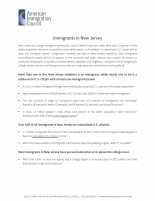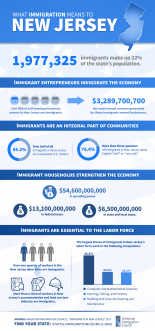- Fact Sheet
Immigrants in New Jersey
Published
New Jersey has a large community of immigrants, many of whom hail from India. Nearly one-quarter of the state’s population was born in another country, while one in six residents is a native-born U.S. citizen with at least one immigrant parent. Foreign-born residents are vital to New Jersey’s workforce across sectors. For example, immigrants account for over two-fifths of all healthcare support workers, nearly half of all workers in computer and math sciences, and half of production employees. As neighbors, business owners, taxpayers, and workers, immigrants are an integral part of New Jersey’s diverse and thriving communities and make extensive contributions that benefit all.
Nearly one in four New Jersey residents is an immigrant, while one in six residents is a native-born U.S. citizen with at least one immigrant parent.
- In 2018, 2 million immigrants (foreign-born individuals) comprised 23 percent of the population.
- New Jersey was home to 991,196 women, 926,641 men, and 115,455 children who were immigrants.
- The top countries of origin for immigrants were India (13 percent of immigrants), Dominican Republic (10 percent), Mexico (5 percent), Ecuador (4 percent), and the Philippines (4 percent).
- In 2018, 1.7 million people in New Jersey (18 percent of the state’s population) were native-born Americans who had at least one immigrant parent.
Nearly three in five immigrants in New Jersey are naturalized U.S. citizens.
- 1.2 million immigrants (59 percent) had naturalized as of 2018, and 321,266 immigrants were eligible to become naturalized U.S. citizens in 2017.
- More than three-quarters (78 percent) of immigrants reported speaking English "well" or "very well."
Most immigrants in New Jersey have pursued education at or above the college level.
- Two in five (40 percent) adult immigrants had a college degree or more education in 2018, while just under one in five (18 percent) had less than a high school diploma.
|
Education Level |
Share (%) of All Immigrants |
Share (%) of All Natives |
|---|---|---|
|
College degree or more |
40 |
41 |
|
Some college |
18 |
25 |
|
High school diploma only |
24 |
27 |
|
Less than a high school diploma |
18 |
6 |
|
Source: U.S. Census Bureau, 2018 American Community Survey 1-Year Estimates. |
||
Over a quarter-million U.S. citizens in New Jersey live with at least one family member who is undocumented.
- 475,000 undocumented immigrants comprised 22 percent of the immigrant population and 5 percent of the total state population in 2016.
- 604,615 people in New Jersey, including 262,527 U.S. citizens, lived with at least one undocumented family member between 2010 and 2014.
- During the same period, about 1 in 11 children in the state was a U.S. citizen living with at least one undocumented family member (180,580 children in total).
New Jersey is home to thousands of Deferred Action for Childhood Arrivals (DACA) recipients.
- 16,350 active DACA recipients lived in New Jersey as of March 2020, while DACA has been granted to 22,171 people in total since 2012.11F
- As of 2019, 32 percent of DACA-eligible immigrants in New Jersey had applied for DACA.12F
- An additional 11,000 residents of the state would satisfy all but the educational requirements for DACA, and fewer than 2,000 would become eligible as they grew older.13F
More than one in four workers in New Jersey is an immigrant, together making up a vital part of the state’s labor force in a range of industries.
- 1.4 million immigrant workers comprised 29 percent of the labor force in 2018.
- Immigrant workers were most numerous in the following industries:
|
Industry |
Number of Immigrant Workers |
|---|---|
|
Health Care and Social Assistance |
212,892 |
|
Manufacturing |
154,555 |
|
Retail Trade |
148,613 |
|
Professional, Scientific, and Technical Services |
141,012 |
|
Construction |
108,195 |
|
Source: Analysis of the U.S. Census Bureau’s 2018 American Community Survey 1-year PUMS data by the American Immigration Council. |
|
- The largest shares of immigrant workers were in the following industries:
|
Industry |
Immigrant Share (%) |
|---|---|
|
Administrative & Support; Waste Management; and Remediation Services |
38 |
|
Manufacturing |
37 |
|
Construction |
34 |
|
Transportation and Warehousing |
34 |
|
Other Services (except Public Administration) |
33 |
|
Source: Analysis of the U.S. Census Bureau’s 2018 American Community Survey 1-year PUMS data by the American Immigration Council. |
|
Immigrants are an integral part of the New Jersey workforce in a range of occupations.
- In 2018, immigrant workers were most numerous in the following occupation groups:
|
Occupation Category |
Number of Immigrant Workers |
|---|---|
|
Management |
143,043 |
|
Transportation and Material Moving |
139,878 |
|
Sales and Related |
130,431 |
|
Office and Administrative Support |
124,765 |
|
Production |
105,201 |
|
Source: Analysis of the U.S. Census Bureau’s 2018 American Community Survey 1-year PUMS data by the American Immigration Council. |
|
- The largest shares of immigrant workers were in the following occupation groups:
|
Occupation Category |
Immigrant Share (%) |
|---|---|
|
Production |
49 |
|
Building and Grounds Cleaning & Maintenance |
48 |
|
Computer and Mathematical |
45 |
|
Healthcare Support |
43 |
|
Farming, Fishing, and Forestry |
41 |
|
Source: Analysis of the U.S. Census Bureau’s 2018 American Community Survey 1-year PUMS data by the American Immigration Council. |
|
- Undocumented immigrants comprised 8 percent of New Jersey’s workforce in 2016.
Immigrants in New Jersey have contributed tens of billions of dollars in taxes.
- Immigrant-led households in the state paid $19.7 billion in federal taxes and $9.5 billion in state and local taxes in 2018.
- Undocumented immigrants in New Jersey paid an estimated $1.1 billion in federal taxes and $604.3 million in state and local taxes in 2018.
- New Jersey DACA recipients and DACA-eligible individuals paid an estimated $57.2 million in state and local taxes in 2018.
As consumers, immigrants add tens of billions of dollars to New Jersey’s economy.
- New Jersey residents in immigrant-led households had $65.8 billion in spending power (after-tax income) in 2018.
Immigrant entrepreneurs in New Jersey generate billions of dollars in business revenue.
- 136,186 immigrant business owners accounted for 33 percent of all self-employed New Jersey residents in 2018 and generated $3.8 billion in business income.
- In 2018, immigrants accounted for 31 percent of business owners in the New York/Northern New Jersey/Long Island metropolitan area (which spans New York, New Jersey, and Pennsylvania) and 14 percent in the Philadelphia/Camden/Wilmington metro area (which extends from Pennsylvania into New Jersey and Delaware).
We can't let the government keep us in the dark.
Join us in demanding transparency and holding them accountable in court to protect our democracy.
Donate Now

